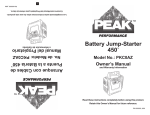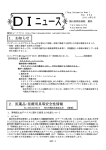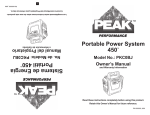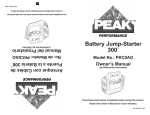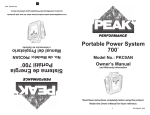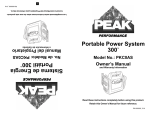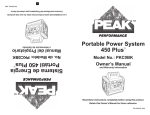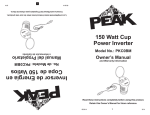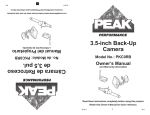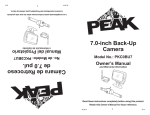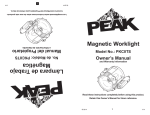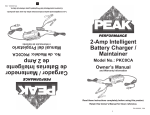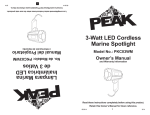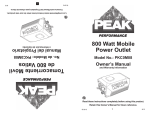Download Arranque con Cables de Puente Recargable Rechargeable
Transcript
© 2015 P-STAR TER ON/OF +US B F 1/15 USB JUM .% 8.8 IN CO CO NN RR EC ECT TION MP PO STAR WE TE R R JU Arranque con Cables de Puente Recargable No. de Modelo: PKC0LS Manual del Propietario e Información de Garantía EC TION T MP PO STAR WE TE R R IN CO CO NN RR EC BAT TER Y TES BUTTO T N JU LIGHT SW ON/OFITCH F 8.8 .% 1 Retain this Owner’s Manual for future reference. Read these instructions completely before using this product. Rese t Input USB LIGHT SW ON/OFITCH F and Warranty Information Owner’s Manual Model No.: PKC0LS Rechargeable Jump-Starter BAT TER Y TES BUTTO T N JUM P-STAR TER ON/OF +US B F USB USB Input Rese t Lea completamente estas instrucciones antes de usar este producto. Conserve este Manual del Propietario para referencia futura. © 2015 1/15 1 ÍNDICE PRECAUCIONES DE SEGURIDAD............................................................................................................. 2 Seguridad del Arranque con Cables de Puente....................................................................... 2 Seguridad de la Batería del Arranque con Cables de Puente................................................... 2 INTRODUCCIÓN......................................................................................................................................... 3 CARACTERÍSTICAS................................................................................................................................... 4 SISTEMA DE GESTIÓN DE LA BATERÍA PEAK......................................................................................... 5 OPERACIÓN............................................................................................................................................... 5 Chequeo de Estado de la Batería del Arranque con Cables de Puente................................... 5 Alerta de Carga Baja (LCA según sus siglas en Inglés)........................................................... 5 Botón de Reposición................................................................................................................ 5 Cargado de la Batería del Arranque con Cables de Puente..................................................... 5 Arranque con Cables de Puente (Sólo Sistemas de Tierra Negativa)...................................... 6 Operación del Tomacorriente USB........................................................................................... 6 Operación de la Linterna LED.................................................................................................. 7 RESOLUCIÓN DE PROBLEMAS................................................................................................................ 7 CUIDADOS Y MANTENIMIENTO................................................................................................................ 7 Almacenaje.............................................................................................................................. 7 Reemplazo del Fusible............................................................................................................. 7 Reemplazo/Descarte de la Batería........................................................................................... 7 ESPECIFICACIONES.................................................................................................................................. 7 INFORMACIÓN DE LA FCC........................................................................................................................ 8 GARANTÍA LIMITADA................................................................................................................................. 8 Para Obtener Servicio.............................................................................................................. 8 PRECAUCIONES DE SEGURIDAD ADVERTENCIA Este producto contiene un químico conocido en el Estado de California como causante de cáncer, defectos de nacimiento o daños al sistema reproductivo. Este símbolo de alerta de seguridad indica que está presente un peligro potencial de lesión personal. Este símbolo es usado usualmente con la palabra de señalamiento (por ejemplo, ADVERTENCIA) la cual designa el grado o nivel de seriedad del peligro. La palabra de señalamiento ADVERTENCIA indica una situación peligrosa que, si no se evita, puede resultar en la muerte o en lesiones serias. La palabra de señalamiento AVISO indica una situación que puede causarle daño al producto, otra propiedad personal y/o al medio ambiente, o causar que el producto funcione de manera incorrecta. La combinación del símbolo de alerta de seguridad y la palabra de señalamiento es usada en mensajes de seguridad a lo largo de este manual y etiquetas de seguridad en este producto. ADVERTENCIA Todos los mensajes de seguridad que siguen tiene niveles de seguridad de ADVERTENCIA. El no cumplirlos puede resultar en la muerte o en lesiones serias. Seguridad del Arranque con Cables de Puente • La batería interna en este Arranque con Cables de Puente es una batería de litio cobalto. Siempre use protección para los ojos y tenga precaución cuando trabaje con baterías de litio cobalto. La batería tiene que ser reciclada o desechada apropiadamente. • Mantenga este Arranque con Cables de Puente lejos del alcance de los niños cuando esté almacenado o en uso. Es necesaria una supervisión cercana cuando se use cerca de los niños. • No opere este Arranque con Cables de Puente en la lluvia o en la nieve, o sumerja la unidad o los adaptadores en agua o en cualquier otro líquido. • No abra el Arranque con Cables de Puente. No hay dentro de la unidad piezas reparables por el usuario. Seguridad de la Batería del Arranque con Cables de Puente • No fume o use artículos inflamables (fósforos, encendedores de cigarrillos, etc.) mientras trabaja en el sistema de batería de un vehículo. • Nunca arranque con cables de puente una batería congelada, ya que puede explotar. • Ejecute el procedimiento de arranque con cables de puente en una área bien ventilada, seca y segura. • No exponga la batería al fuego o al calor intenso ya que puede explotar. • Antes de reciclar o desechar la batería, proteja los terminales descubiertos con cinta aislante eléctrica para evitar cortocircuitos (un cortocircuito puede resultar en heridas corporales o en un incendio). • Siga estos procedimientos de primeros auxilios en caso de contacto accidental con ácido de batería. 2 • Do not smoke or use flammable items (matches, cigarette lighters, etc.) while working on a vehicle’s battery system. • Never jump-start a frozen battery, as it could explode. • Perform all jump-starting procedures in a safe, dry, well-ventilated area. • Do not expose battery to fire or intense heat since it can explode. • Before recycling or disposing of a battery, protect exposed terminals with heavy-duty electrical tape to prevent shorting (shorting can result in personal injury or fire). • Follow these first aid procedures in case of accidental contact with battery acid. 2 Battery Jump-Starting Safety • The internal battery in this Jump-Starter is a lithium cobalt battery. Always wear eye protection and exercise caution when working with lithium cobalt batteries. The battery must be recycled or disposed of properly. • Whether stored or in use, keep this Jump-Starter out of reach of children. Close supervision is necessary when used near children. • Do not operate this Jump-Starter in rain or snow, or immerse the unit or adapters in water or other liquid. • Do not open the Jump-Starter. There are no user-serviceable parts inside the unit. Jump-Starter Safety All safety messages that follow have WARNING level hazards. Failure to comply could result in death or serious injury. This safety alert symbol indicates that a potential personal injury hazard is present. The symbol is usually used with a signal word (e.g., WARNING) which designates the degree or level of hazard seriousness. The signal word WARNING indicates a hazardous situation which, if not avoided, could result in death or serious injury. The signal word NOTICE indicates a situation which can cause damage to the product, other personal property and/or to the environment, or cause the product to operate improperly. The combination of the safety alert symbol and signal word is used in safety messages throughout this manual and on safety labels on this product. This product contains a chemical known to the State of California to cause cancer or birth defects or other reproductive harm. SAFETY PRECAUTIONS SAFETY PRECAUTIONS................................................................................................................. 2 Jump-Starter Safety................................................................................................................. 2 Battery Jump-Starting Safety................................................................................................... 2 INTRODUCTION.............................................................................................................................. 3 FEATURES....................................................................................................................................... 4 PEAK BATTERY MANAGEMENT SYSTEM..................................................................................... 5 OPERATION..................................................................................................................................... 5 Checking Jump-Starter Battery Status..................................................................................... 5 Low Charge Alert (LCA)........................................................................................................... 5 Reset Button............................................................................................................................ 5 Charging Jump-Starter Battery................................................................................................ 5 Jump-Starting (Negative Ground Systems Only)..................................................................... 6 USB Power Outlet Operation.................................................................................................... 6 LED Flashlight Operation......................................................................................................... 6 TROUBLESHOOTING...................................................................................................................... 7 CARE AND MAINTENANCE............................................................................................................ 7 Storage.................................................................................................................................... 7 Fuse Replacement................................................................................................................... 7 Battery Replacement/Disposal................................................................................................. 7 SPECIFICATIONS............................................................................................................................ 7 FCC INFORMATION......................................................................................................................... 7 LIMITED WARRANTY...................................................................................................................... 8 To Obtain Service..................................................................................................................... 8 CONTENTS 3 PRIMEROS AUXILIOS PIEL: Lávese la piel completamente si el ácido de batería entra en contacto con la piel. Obtenga inmediatamente atención médica. OJOS: Enjuáguese los ojos con agua fría durante por lo menos diez minutos. Obtenga inmediatamente atención médica. SI SE INGIERE, PÓNGASE INMEDIATAMENTE EN CONTACTO CON UN CENTRO DE CONTROL DE ENVENENAMIENTO. This Jump-Starter has been carefully engineered and manufactured to give you dependable operation. Please read this manual thoroughly before operating your new Jump-Starter, as it contains the information you need to become familiar with its features and obtain the performance that will bring you continued enjoyment for many years. Please keep this manual on file for future reference. INTRODUCTION • Vehicles that have on-board computerized systems may be damaged if vehicle battery is jumpstarted. Before jump-starting, read the vehicle’s owner’s manual to confirm that external-starting assistance is suitable. • Excessive engine cranking can damage a vehicle’s starter motor. If the engine fails to start after the recommended number of attempts, discontinue these jump-start procedures and look for other problems that may need to be corrected. • This Jump-Starter is not designed to be used as a replacement for a vehicle’s battery. Do not attempt to operate a vehicle that does not have a battery installed. • After connecting the battery charging clamps to the discharged battery and before turning on the jump-starter ON/OFF switch, check the power/polarity indicator light on the front of the unit. If the light turns GREEN, the clamp connections are correct. If the light turns RED and an alarm sounds, the clamp connections are incorrect and need to be reversed. • This Jump-Starter is delivered in a partially charged state. Fully charge unit with the supplied 110/120-volt AC charger or the 12-volt DC charger for 5-6 hours or until FL displays on the battery status indicator display. • To avoid possible damage that may shorten the unit’s working life, protect it from direct sunlight, direct heat and/or moisture. • Never allow battery acid to come in contact with this unit. • All ON/OFF switches should be in the OFF position when charging the Jump-Starter or when not in use. Make sure all switches are in the OFF position before connecting to a power source or load. • Do not use any accessory that is not recommended or provided by the manufacturer. All messages that follow have NOTICE level hazards. Failure to comply could result in property damage. • Never touch battery clamps together or to a common piece of metal. Sparking, explosion, or damage to the unit can result. Always disconnect battery clamps and store properly after use. • Place this unit as far away from the battery being charged as the charging cables will permit. • When using the Jump-Starter close to the vehicle’s battery and engine, place the unit on a flat, stable surface, and keep all clamps, cords, clothing and body parts away from moving parts of the vehicle. • Follow these instructions and those published by the battery manufacturer and manufacturer of any equipment you intend to use near the battery. Pay attention to all hazard precautions on these products and on the engine before charging. • This system is designed to be used only on vehicles with a 12-volt DC battery system. Do not connect to a 6-volt or 24-volt battery system. • When working on electrical equipment, always ensure someone is nearby to help you in an emergency. • Nunca toque las pinzas de la batería entre sí o contra un pedazo de metal común. Podrá resultar en chispas, explosión o daños a la unidad. Siempre desconecte las pinzas de la batería y guárdelas apropiadamente después de casa uso. • Coloque esta unidad tan lejos de la batería que se está cargando como lo permitan los cables de carga. • Cuando use el Arranque con Cables de Puente cerca de la batería y del motor del vehículo, coloque la unidad sobre una superficie plana y estable, mantenga todas las pinzas, cordones, ropa y partes del cuerpo alejados de las piezas en movimiento del vehículo. • Siga estas instrucciones y aquellas publicadas por el fabricante de la batería y por el fabricante de cualquier equipo que usted intente usar cerca de la batería. Antes de cargar, préstele atención a las precauciones de peligro en estos productos y en el motor. • Este sistema fue diseñado para ser usado sólo en vehículos con sistema de batería de 12 voltios CC. No lo conecte a un sistema de batería de 6 ó 24 voltios. • Cuando trabaje en equipos eléctricos, siempre tenga a alguien cerca para que lo ayude en caso de una emergencia. AVISO Todos los mensajes que siguen tiene niveles de peligro de AVISO. El no cumplirlos puede resultar en daños a la propiedad. • Los vehículos que tiene sistemas computarizados a bordo pueden sufrir daños si la batería del vehículo es arrancada con cables de puente. Antes de arrancar con cables de puente, lea el manual del propietario del vehículo para confirmar si la asistencia de arranque externa es apropiada. • El darle arranque excesivamente al motor puede dañar el motor de arranque. Si el motor falla en arrancar después de el número recomendado de intentos, descontinúe el procedimiento de arranque con cables de puente y busque otros problemas que necesiten ser corregidos. • Este Arranque con Cables de Puente no fue diseñado para que se use como reemplazo de la batería del vehículo. No intente operar un vehículo que no tenga una batería instalada. • Después de conectar las pinzas de carga de batería en la batería descargada y antes de encender el interruptor de ON/OFF de arranque con cables de puente, verifique la luz del indicador de energía/ polaridad ubicada en el frente de la unidad. Si la luz se enciende en VERDE, las conexiones de las pinzas están correctas. Si la luz se enciende en ROJO y la alarma suena, las conexiones de las pinzas están incorrectas y necesitan ser invertidas. • Este Arranque con Cables de Puente se entrega en un estado de carga parcial. Cargue completamente la unidad con el cargador de 110/120 voltios CA o con el cargador de 12 voltios CC durante 5 a 6 horas o hasta que aparezca FL (lleno) en la pantalla indicadora de estado de la batería. • Para evitar posibles daños que le pueden acortar la vida de trabajo a la unidad, protéjala de la luz solar directa, calor directo y/o humedad. • Nunca permita que el ácido de batería entre en contacto con esta unidad. • Todos los interruptores de ON/OFF deben estar en la posición OFF cuando el Arranque con Cables de Puente esté siendo cargado o no esté siendo usado. Asegúrese de que todos los interruptores estén en la posición OFF antes de conectar la unidad a una fuente de energía o carga. • No use ningún accesorio que no sea recomendado o suministrado por el fabricante. INTRODUCCIÓN Este Arranque con Cables de Puente ha sido diseñado y fabricado cuidadosamente para proporcionarle una operación confiable. Por favor lea completamente este manual antes de operar su nuevo Arranque con Cables de Puente, ya que contiene la información que usted necesita para familiarizarse con sus características y obtener el rendimiento que le dará satisfacción continua por muchos años. Por favor guarde este manual para referencia futura. FIRST AID SKIN: Wash skin thoroughly if battery acid comes in contact with skin. Seek medical attention immediately. EYES: Flush eyes with cool water for at least ten minutes. Seek medical attention immediately. CONTACT POISON CONTROL CENTER IMMEDIATELY IF INGESTED. 3 • • • • • • • • • • • • CARACTERÍSTICAS Sistema de Gestión de la Batería Peak Salidas de energía USB incorporado de 2.1 amp Linterna LED incorporada que también puede ser una luz estroboscópica o destellar la señal de SOS LEDs indicadores de nivel de batería (indican el % de carga) Indicador LED de conexión incorrecta con alarma sonora Incluye batería sellada, libre de mantenimiento, para trabajo pesado, de litio cobalto No necesita mantenimiento (fuera de cargarla) para operación óptima Cargador de 110/120 voltios CA Cargador de 12 voltios CC Fácil de usar, transportar y almacenar La carcasa moldeada de alto impacto es fuerte y durable Alerta de Carga Baja (LCA™ según sus siglas en Inglés) 1 2 3 4 LIGHT SW ON/O ITCH FF BATT ER BUTTY TEST ON 5 JUMP -STAR ON/OTER+US B FF USB USB Inpu t 14 9 Reset 13 12 11 10 9 10 7 USB 8 11 Reset JUMP .% 8.8 IN CO CO NN RR EC ECT TIO N MP PO STA WER RTER JU 6 16 17 BATT ER BUTTY TEST ON 15 7 12 13 t Leyenda 1. 2. 3. 2 Linterna LED 10. Puerto de Carga 11. Puertos USB 12. Interruptor ON/OFF del USB/Arranque con Cables de Puente 13. Botón de Prueba de la Batería 14. Interruptor ON/OFF de la Linterna LED 15. Enchufe de los Cables del Arranque con Cables de Puente 16. Cable de Puente Positivo (+) Rojo 17. Cable de Puente Negativo (-) Negro 18. Protección contra Carga Inversa Puerto para los Cables del Arranque con Cables de Puente LED de Energía del Arranque con Cables de Puente LED de Conexión Incorrecta Pantalla Indicadora de Estado de la Batería Adaptador de Carga de 110/120 voltios CA Adaptador de Carga de 12 voltios CC Fusible de 2A Botón de Reposición Peak Battery Management System 2.1 amp built-in USB power outlets Built-in LED flashlight that can also be a strobe light or flash the SOS signal Battery indicator LEDs (indicate % of charge) Incorrect connection LED indicator with sound alarm Includes sealed, maintenance-free, heavy-duty, lithium cobalt battery Requires no maintenance (other than recharging) for optimal operation 110/120-volt AC charger 12-volt DC charger Safe to use, transport and store Molded high-impact case is tough and durable Low Charge Alert (LCA)™ FEATURES 4. 5. 6. 7. 8. 9. LIGHT SW ON/O ITCH FF 18 8.8 . % IN CO CO NN RR EC ECT TIO N Charging Port USB Ports Jump-Starter/USB ON/OFF Switch Battery Test Button LED Flashlight ON/OFF Switch Jump-Starter Cables Plug Red Positive (+) Jumper Cable Black Negative (-) Jumper Cable Reverse Charge Protection MP PO STA WER RTER 10. 11. 12. 13. 14. 15. 16. 17. 18. 16 JU 4 Legend 1. LED Flashlight 2. Jump-Starter Cables Port 3. Jump-Starter Power LED 4. Incorrect Connection LED 5. Battery Status Indicator Display 6. 110/120-volt AC Charging Adapter 7. 12-volt DC Charging Adapter 8. 2A Fuse 9. Reset Button 17 6 8 14 Inpu USB -STAR ON/OTER+US B FF 15 18 5 3 4 1 4 • • • • • • • • • • • • 5 110/120-Volt AC Charging 1. Make sure the LED flashlight and the jump-starter/USB switch are off. 2. Insert the end of the AC charging adapter into the charge port on the Jump-Starter. 3. Plug the charging adapter into a 110/120-volt AC outlet. The battery percentage will display for a moment, and then the jump-starter power LED light will turn on and two dashes will begin to scroll across the battery status indicator display. 4. When the battery is fully charged, FL will display on the battery status indicator display. 5. Disconnect the charging adapter from the 110/120-volt AC outlet. 6. Disconnect the charging adapter from the charging port. 7. Turn off the battery status indicator display. The battery status indicator display will turn off automatically after approximately 20 seconds. For best performance, the Jump-Starter should be fully recharged every 6 months. Typical charge time is 5-6 hours. • Fully charge unit for 5-6 hours or until FL displays on the battery status indicator display. • Recharge the unit fully after each use. • Make sure all functions of the Jump-Starter are turned off during recharging. The Jump-Starter should only be charged when the temperature of the Jump-Starter is between 32°F-104°F (0°C-40°C). The Jump-Starter should only be operated when the unit’s temperature is 14°F-113°F (-10°C-45°C). Charging Jump-Starter Battery If one of the protection systems from the Peak Battery Management Systems is activated, the JumpStarter may need to be reset. Use a small, thin object such as a paper clip to push in the reset button. When the reset button is being pushed in, the green LED will light momentarily. Reset Button When the battery level drops to “LO,” an alarm will sound to remind the user to recharge the JumpStarter. When the low charge alert alarm sounds, the Jump-Starter should be charged as soon as possible. Pressing the battery test button will silence the alarm for 1 hour. Low Charge Alert (LCA) Press and hold the battery status button, located on the front of the unit, to check the Jump-Starter battery charge level. The battery indicator display will indicate battery charge state as a percentage of the full battery capacity. Checking Jump-Starter Battery Status OPERATION Overcharge Protection: When the battery is fully charged, this protection feature prevents the battery from being overcharged. Low Voltage Warning: When the battery is low, this protection feature will sound an alarm. Low Voltage Shutdown: When the battery is completely discharged, this protection feature will turn off the Jump-Starter until it is charged. After charging the Jump-Starter, the reset button must be pressed in. Overload Protection: When too much current is drawn from the Jump-Starter, this protection feature will turn off the Jump-Starter until the reset button is pressed. Short Circuit Protection: When a short circuit occurs, this protection feature will turn off the JumpStarter until the reset button is pressed. Incorrect Connection Alarm: When the jump starter clamps are connected to the battery incorrectly while the jump starter/USB switch is in the OFF position, this protection feature will sound an alarm and the red incorrect connection LED will light. Reverse Charge Protection: After a successful crank, this protection feature will prevent the vehicle’s battery/charging system from charging the lithium cobalt Jump-Starter battery. PEAK BATTERY MANAGEMENT SYSTEM SISTEMA DE GESTIÓN DE LA BATERÍA PEAK Protección de Sobrecarga: Cuando la batería está completamente cargada, esta dispositivo de protección evita que la batería sea sobrecargada. Advertencia de Bajo Voltaje: Cuando la batería está baja, este dispositivo de protección activará una alarma sonora. Apagado de Bajo Voltaje: Cuando la batería está completamente descargada, este dispositivo de protección apagará el Arranque con Cables de Puente hasta que quede cargado. Después de cargar el Arranque con Cables de Puente, el botón de reposición deberá ser oprimido. Protección de Sobre Carga: Cuando demasiada corriente es extraída del Arranque con Cables de Puente, este dispositivo de protección apagará el Arranque con Cables de Puente hasta que el botón de reposición sea oprimido. Protección de Cortocircuito: Cuando ocurre un corto circuito, este dispositivo de protección apagará el Arranque con Cables de Puente hasta que el botón de reposición sea oprimido. Alarma de Conexión Incorrecta: Cuando las pinzas del Arranque con Cables de Puente son conectadas a la batería incorrectamente mientras que el interruptor USB/Arranque con Cables de Puente está en la posición OFF, este dispositivo de protección encenderá una alarma y la luz LED de conexión incorrecta. Protección contra Carga Inversa: Después de una arrancada exitosa, este dispositivo de protección evitará que el sistema de carga de la batería del vehículo cargue la batería de litio cobalto del Arranque con Cables de Puente. OPERACIÓN Chequeo de Estado de la Batería de Arranque con Cables de Puente Oprima y sostenga el botón de estado de la batería, ubicado en la parte frontal de la unidad, para chequear el nivel de carga de la batería del Arranque con Cables de Puente. La pantalla indicadora de nivel de batería mostrará el estado de carga de la batería como un porcentaje de la capacidad total de la batería. Alerta de Carga Baja (LCA según sus siglas en Inglés) Cuando el nivel de la batería desciende a “LO” (BAJO), sonará una alarma para recordarle al usuario que debe recargar el Arranque con Cables de Puente. Cuando suena la alarma de alerta de carga baja, el Arranque con Cables de Puente deberá ser cargado tan pronto sea posible. El oprimir el botón de prueba de la batería silenciará la alarma durante 1 hora. Botón de Reposición Si uno de los sistemas de protección del Sistema de Gestión de la Batería Peak es activado, pueda que se necesite reposicionar el Arranque con Cables de Puente. Use un objeto pequeño tal como una presilla de papel para oprimir el botón de reposición. Cuando el botón de reposición está siendo oprimido, la luz LED verde se encenderá momentáneamente. Cargado de la Batería de Arranque con Cables de Puente Para obtener mejor rendimiento, el Arranque con Cables de Puente deberá ser cargado completamente cada 6 meses. El tiempo de carga típico es de 5 a 6 horas. • Cargue completamente la unidad durante 5 a 6 horas o hasta que indique FL (llena) en la pantalla del indicador de estado de la batería. • Recargue completamente la unidad después de cada uso. • Asegúrese de que todas las funciones del Arranque con Cables de Puente estén apagadas durante la recarga. AVISO El Arranque con Cables de Puente sólo deberá ser cargado cuando la temperatura del aparato esté entre 32 °F-104 °F (0 °C-40 °C). El Arranque con Cables de Puente sólo deberá ser operado cuando la temperatura de la unidad esté entre 14 °F-113 °F (-10 °C-45 °C). Carga de 110/120 Voltios CA 1. 2. 3. 4. 5. 6. 7. Asegúrese de que los interruptores de la linterna LED y del USB/Arranque con Cables de Puente estén apagados. Inserte el extremo del adaptador de carga CA dentro del puerto del carga del Arranque con Cables de Puente. Enchufe el adaptador de carga en un tomacorriente de 110/120 voltios CA. El porcentaje de la batería aparecerá por un momento, y luego la luz LED de energía del Arranque con Cables de Puente se encenderá y dos rayas comenzarán cruzar por la pantalla indicadora de estado de la batería. Cuando la batería está completamente cargada, aparecerá FL (lleno) en la pantalla indicadora de estado de la batería. Desconecte el adaptador de carga del tomacorriente de 110/120 voltios CA. Desconecte el adaptador de carga del puerto de carga. Apague la pantalla indicadora de estado de la batería. La pantalla indicadora de estado de la batería se apagará automáticamente después de aproximadamente 20 segundos. Carga de 12 Voltios CC 1. 2. 3. Asegúrese de que los interruptores de la linterna LED y del USB/Arranque con Cables de Puente estén apagados. Inserte el extremo del adaptador de carga CC dentro del puerto del carga del Arranque con Cables de Puente. Enchufe el adaptador de carga en una salida estándar de accesorios de 12 voltios en el vehículo (es decir, encendedor de cigarrillos). El porcentaje de la batería aparecerá por un momento, y luego la luz 5 4. 5. 6. 7. LED de energía del Arranque con Cables de Puente se encenderá y dos rayas comenzarán cruzar por la pantalla indicadora de estado de la batería. Cuando la batería está completamente cargada, aparecerá FL (lleno) en la pantalla indicadora de estado de la batería. Desconecte el adaptador de carga de la salida de accesorios de 12 voltios del vehículo. Desconecte el adaptador de carga del puerto de carga. Apague la pantalla indicadora de estado de la batería. La pantalla indicadora de estado de la batería se apagará automáticamente después de aproximadamente 20 segundos. Arranque con Cables de Puente (Sólo Sistemas de Tierra Negativa) Inserte el enchufe de los cables del Arranque con Cables de Puente en el puerto del Arranque con Cables de Puente. Este Arranque con Cables de Puente está equipado con un interruptor manual de ON/OFF de Arranque con Cables de Puente/USB. Antes de encender este interruptor, verifique el indicador de conexión incorrecta después de haber conectado ambas pinzas de los cables de Arranque con Cables de Puente. Si la luz es ROJA y la alarma suena, las conexiones de las pinzas están incorrectas y necesitan ser invertidas. No encienda el interruptor de Arranque con Cables de Puente/USB si la luz LED de conexión incorrecta esta encendido. Nota: Se necesita un 77% de capacidad de batería antes de intentar arrancar un vehículo con cables de puente. ADVERTENCIA PELIGRO DE EXPLOSIÓN Nunca permita que las pinzas de los cables de arranque con cables de puente (roja y negra) se toquen entre sí o contra un conductor de metal común. Esto podrá causarle daños a la unidad y/o crear un peligro de chispas/explosión. Siempre apague el interruptor ON/OFF del Arranque con Cables de Puente y almacene apropiadamente las pinzas del Arranque con Cables de Puente después de usarlo. ADVERTENCIA PELIGRO DE EXPLOSIÓN Las conexiones de las pinzas de arranque con cables de puente en la baterías del vehículo tienen que ser positivo con positivo (pinza roja al terminal “+” de la batería) y el negativo (pinza negra) al punto de tierra tal como el chasis metálico del vehículo. Una conexión incorrecta (positivo a negativo) podrá causarle daños a la unidad y/o crear peligros de chispas/explosión. 1. 2. 3. 4. 5. 6. 7. Apague la ignición y todos los accesorios del vehículo. Asegúrese de que el Arranque con Cables de Puente esté completamente cargado y que el interruptor de ON/OFF de Arranque con Cables de Puente esté en la posición OFF. Apague cualquiera otra función de su Arranque con Cables de Puente. Consulte el manual del propietario del vehículo para obtener el procedimiento apropiado para arrancar con cables de puente. Muchos vehículos recientes tienen una ubicación separada para arranque con cables de puente, alejada de la batería. Siempre use el procedimiento recomendado por el fabricante de su vehículo. Conecte seguramente el cable rojo positivo (+) al terminal (+) de arranque con cables de puente del vehículo. Conecte el cable negativo negro (–) a una pieza metálica del vehículo que no tenga movimiento. No lo conecte al terminal negativo (–) de la batería. Asegúrese de que la luz LED de conexión incorrecta no esté encendida. Si está encendida, los cables de Arranque con Cables de Puente no están instalados correctamente. Deténgase inmediatamente y revise sus conexiones. Continúe sólo si la luz LED de conexión incorrecta no esté encendida. Después de verificar que las conexiones están correctas, coloque el interruptor de ON/OFF del Arranque con Cables de Puente/USB en la posición ON. Dele arranque al motor con ráfagas de 3 segundos. AVISO No le dé arranque al motor por más de 3 segundos. El arranque con cables de puente fue diseñado sólo para operación de corto tiempo. El operar el arranque con cables de puente durante más de 3 segundos podrá causarle daños a la unidad. Deje que el Arranque con Cables de Puente se enfríe durante por lo menos 1 minuto después de cada arrancada con cables de puente. 8. Una vez que el motor prenda, GIRE EL INTERRUPTOR DE ON/OFF DE ARRANQUE CON CABLES DE PUENTE A LA POSICIÓN OFF Y DESCONECTE PRIMERO LA PINZA NEGRA NEGATIVA y luego la pinza roja positiva. 9. Remueva el conector de los cables del Arranque con Cables de Puente del Arranque con Cables de Puente. 10. Después de cada uso, recargue el Arranque con Cables de Puente tan pronto le sea posible. Operación del Tomacorriente USB ADVERTENCIA PELIGRO DE INCENDIO Antes de usar los puertos USB, asegúrese de que el enchufe de los cables del arranque con cables de puente esté desconectado del puerto del Arranque con Cables de Puente. Cuando el interruptor del arranque con cables de puente/USB está encendido, los cables estarán activos si están conectados al Arranque con Cables de Puente. AVISO El tomacorriente USB no apoya las comunicaciones de datos. El tomacorriente tiene un máximo de 5 voltios/2100 mA CC de energía para un dispositivo externo USBenergizado. 6 FIRE HAZARD Before using the USB ports, make sure the jump-starter cables plug is disconnected from the jump-starter cables port on the Jump-Starter. When the jump-starter/USB port switch is turned on, the cables will be active if they are connected to the Jump-Starter. The USB power outlet does not support data communication. The outlet has a maximum of 5 volts/2100 mA DC power to an external USB-powered device. 1. Plug the USB-powered device into the USB power outlet. 2. Turn on the jump-starter/USB ON/OFF switch. 3. Switch the device on. 4. When shutting down, turn the power of the device off first, and then turn the jump-starter/USB ON/OFF switch off. 5. Unplug the USB-powered device from the USB power outlet. 6 USB Power Outlet Operation EXPLOSION HAZARD Jump-start cable clamp connections at the vehicle’s battery terminals must be positive to positive (red clamp to battery “+”) and negative (black clamp) to the grounding point such as the metal frame of the vehicle. An incorrect connection (positive to negative) may cause damage to the unit and/or create a sparking/explosion hazard. 1. Turn off ignition and all vehicle accessories. 2. Make sure the Jump-Starter is fully charged and jump-starter/USB ON/OFF switch is in the OFF position. Turn any additional functions of your Jump-Starter off. 3. Check your vehicle’s owners manual for proper jump-starting procedure. Many newer vehicles have a separate location for jump-starting, away from the battery. Always use the vehicle manufacturer’s recommended procedure. 4. Securely connect the red positive (+) cable to the vehicle’s positive (+) jumping terminal. 5. Connect the black negative (-) cable to a non-moving metal part on the vehicle. Do not connect to the negative (-) battery terminal. Make sure the red incorrect connection LED is not on. If it is on, the jump-starter cables are not installed correctly. Immediately stop and recheck your connections. Only continue if the red incorrect connection LED is not lit. 6. After verifying that connections are correct, turn the jump-starter/USB ON/OFF switch to the ON position. 7. Crank the engine in 3-second bursts. Do not crank the engine for more than 3 seconds. The jump-start feature is designed for short-term operation only. Operating the jump-start feature for more than 3 seconds may cause damage to the unit. Allow the Jump-Starter to cool down for at least 1 minute after each jump-start. 8. Once engine has started, TURN THE JUMP-STARTER ON/OFF SWITCH TO THE OFF POSITION AND DISCONNECT THE BLACK NEGATIVE CLAMP FIRST and then the red positive clamp. 9. Remove the jump-starter cables plug from the jump-starter cables port on the Jump-Starter. 10. Recharge the Jump-Starter as soon as possible after each use. EXPLOSION HAZARD Never allow the jump-start cable clamps (red and black) to touch each other or another common metal conductor. This could cause damage to the unit and/or create a sparking/ explosion hazard. Always switch off the jump-starter ON/OFF switch and store the jump-start clamps appropriately after use. Insert the jump-starter cables plug into the jump-starter cables port on the Jump-Starter. This Jump-Starter is equipped with a manual jump-starter/USB ON/OFF switch. Before turning this switch on, check the incorrect connection indicator after both jump-start cable clamps have been connected. If the light is RED and an alarm sounds, the clamp connections are incorrect and need to be reversed. Do not turn the jump-starter/USB switch on if the incorrect connection LED is lit. Note: A minimum of 77% battery capacity is needed before attempting to jump-start a vehicle. Jump-Starting (Negative Ground Systems Only) 12-Volt DC Charging 1. Make sure the LED flashlight and the jump-starter/USB switch are off. 2. Insert the end of the DC charging adapter into the charge port on the Jump-Starter. 3. Plug the charging adapter into any standard 12-volt vehicle accessory outlet (e.g., cigarette lighter). The battery percentage will display for a moment, and then the jump-starter power LED light will turn on and two dashes will begin to scroll across the battery status indicator display. 4. When the battery is fully charged, FL will display on the battery status indicator display. 5. Disconnect the charging adapter from the 12-volt vehicle accessory outlet. 6. Disconnect the charging adapter from the charging port. 7. Turn off the battery status indicator display. The battery status indicator display will turn off automatically after approximately 20 seconds. 7 1. 2. 3. 4. Built-in battery Lithium cobalt 2. USB power outlet 5 volts/2.1 A 2. 3. 4. 3. LED flashlight One LED 4. Charging time 5-6 hours 1. 5. Charging temperature 32°F-104°F (0°C-40°C) 5. 6. Storage and operating temperature 14°F-113°F (-10°C-45°C) 1. SPECIFICATIONS Li+ The Jump-Starter is designed to provide years of service. However, when the internal battery reaches the end of its service life, the Jump-Starter itself is no longer of use. The internal battery is not designed to be user replaceable. The Jump-Starter contains a lithium cobalt battery. The Jump-Starter should be recycled or safely disposed of at a local recycling center. Examples of places that will accept items like this are: county or municipal recycling drop-off centers, scrap metal dealers and retailers who sell replacement lithium ion batteries. Battery Replacement / Disposal 1. 2. 3. 4. Turn the cap on the tip of the power plug counterclockwise. Remove the cap, center pin and fuse. Replace the fuse with a new 2-amp fuse. Replace the center pin and cap. Turn the cap clockwise. Fuse Replacement Store the Jump-Starter at room temperature. Make sure the battery clamps are stored properly. For best performance, the Jump-Starter should be fully recharged every 6 months. Typical charge time is 5-6 hours. Poor jump-starting may result if not fully recharged every 6 months. Storage CARE AND MAINTENANCE No voltage at Low voltage shutdown jumper cables or green jump starter Overload protection power LED is not lit Short circuit protection Charge battery and press reset button Red incorrect connection LED is lit and alarm sounds Incorrect connection Correct jumper cables correctly Alarm sounds Low voltage Charge battery and then press reset button Problem 1. 2. 3. 4. Situation Press reset button Action TROUBLESHOOTING Press the LED flashlight switch once to turn on the LED flashlight. It will remain a steady beam. Pressing the switch a second time will change the steady beam to a strobe light. Pressing the switch a third time will make the light flash the SOS signal. Pressing the switch a fourth time will turn OFF the LED flashlight. LED Flashlight Operation Enchufe el dispositivo energizado por USB dentro del tomacorriente USB. Encienda el interruptor de ON/OFF del arranque con cables de puente/USB. Encienda el aparato. Cuando apague, primero apague el artefacto y luego apague el interruptor de ON/OFF del arranque con cables de puente/USB. Desenchufe el dispositivo energizado USB del tomacorriente USB. Operación de la Linterna LED Oprima el interruptor de la linterna LED una vez en la linterna LED. Se mantendrá con una chorro de luz continuo. El oprimir el interruptor una segunda vez cambiará la luz continua a una luz estroboscópica. El oprimir el interruptor una tercera vez hará que la luz emita la señal de SOS. El oprimir el botón una cuarta vez apagará la linterna LED. RESOLUCIÓN DE PROBLEMAS Problema No hay voltaje en los cables de puente o la luz LED de energía del arranque con cables de puente no esté encendida Situación Apagado de bajo voltaje Acción Cargue la batería y oprima el botón de reposición Protección de sobrecarga Oprima el botón de reposición Protección de corto circuito Bajo voltaje La alarma suena Conexión incorrecta El LED de conexión incorrecta rojo está encendido y la alarma suena Corrija la conexión de los cables de puente Cargue la batería y luego oprima el botón de reposición CUIDADOS Y MANTENIMIENTO Almacenaje Almacene el Arranque con Cables de Puente a temperatura ambiente. Asegúrese de que las pinzas de la batería están almacenadas correctamente AVISO Para obtener mejor rendimiento, el Arranque con Cables de Puente deberá ser cargado completamente cada 6 meses. El tiempo de carga típico es de 5 a 6 horas. Arranque con cables de puente pobre podrá ocurrir si no es recargado cada 6 meses. Reemplazo del Fusible 1. 2. 3. 4. Gire la tapa de la punta del enchufe de energía en el sentid o contra horario. Remueva la tapa, el pasador central y el fusible. Reemplace el fusible por uno de 2 amperios. Reinstale el pasador central y la tapa. Gire la tapa en el sentido horario. Reemplazo / Descarte de la Batería El Arranque con Cables de Puente fue diseñado para proporcionarle años de servicio. Sin embargo, cuando la batería interna llegue al fin de su vida útil de servicio, el Arranque con Cables de Puente no sirve para nada. La batería interna no fue diseñada para ser reemplazada por el usuario. El Arranque con Cables de Puente contiene una batería de litio cobalto. El Arranque con Cables de Puente deberá ser reciclado o desechado seguramente en un centro de reciclado local. Ejemplos de lugares que acepta artículos como este son: centros de reciclaje del condado o municipales, distribuidores de chatarra y minoristas que venden baterías de iones de litio. Li+ ESPECIFICACIONES Temperatura de operación y 14 °F a 113 °F (-10 °C a 45 °C) almacenaje 6. Temperatura de carga 5. Tiempo de carga 4. Linterna de LED 3. Tomacorriente USB 2. Batería integrada 1. Litio cobalto 5 voltios/2,1 A Un LED 5-6 horas 32 °F a 104 °F (0 °C a 40 °C) 7 INFORMACIÓN DE LA FCC Este producto cumple con la Parte 15 de las Reglas de la FCC. La operación está sujeta a las siguientes dos condiciones: (1) este dispositivo no deberá causar interferencia dañina, y (2) este dispositivo deberá aceptar cualquier interferencia recibida, incluyendo interferencia que pueda causar la operación indeseada. ADVERTENCIA Cambios o modificaciones a esta unidad no aprobadas expresamente por la parte responsable de cumplimiento podrá anular la autoridad del usuario para operar el equipo. AVISO Este producto ha sido probado y se encontró que cumple con los límites de un dispositivo digital Clase B, conforme a la Parte 15 de las Reglas de la FCC. Estos límites fueron diseñados para suministrar protección razonable contra interferencias dañinas en una instalación residencial. Este equipo genera, usa y puede radiar energía de frecuencia radial y si no es instalado y usado de acuerdo con las instrucciones, podrá causar interferencia dañina para las comunicaciones radiales. Sin embargo, no hay garantía de que dicha interferencia no ocurra en una instalación en particular. Si este equipo causa interferencia dañina a la recepción de radio o televisión, lo cual puede ser determinado apagando y encendiendo el equipo, alentamos al usuario para que trate de corregir la interferencia por medio de una o más de las siguientes medidas: • Reoriente o reubique la entena receptora. • Aumente la separación entre el equipo y el receptor. • Conecte el equipo en una toma de corriente de un circuito diferente al que el receptor está conectado. • Consulte al agente o a un técnico de radio/TV para obtener ayuda. GARANTÍA LIMITADA El fabricante le garantiza al consumidor original, o comprador, que el Arranque con Cables de Puente PEAK® PKC0LS estará libre de defectos en material y mano de obra durante un año a partir de la fecha de venta al comprador original. El fabricante por la presente excluye y renuncia a cualquier otra garantía, expresa o implícita, más allá de aquellas garantías especificadas anteriormente. El fabricante excluye cualquier garantía implícita de comerciabilidad o de aptitud para un propósito en particular. SI SU ARRANQUE CON CABLES DE PUENTE PEAK® TIENE UN MAL FUNCIONAMIENTO DEBIDO A UN DEFECTO EN MATERIAL O MANO DE OBRA DENTRO DE UN PERÍODO DE GARANTÍA DE UN AÑO, EL FABRICANTE A SU ELECCIÓN LA REPARARÁ O CAMBIARÁ. EL FABRICANTE, SIN EMBARGO, NO SERÁ RESPONSABLE POR NINGÚN DAÑO A SU PRODUCTO DEBIDO A CUALQUIER CAUSA QUE NO SE DEBA A DEFECTOS EN MATERIAL O MANO DE OBRA, INCLUYENDO SIN LIMITACIONES: NO SEGUIR LAS INSTRUCCIONES DE USO, MAL USO, REPARACIONES EFECTUADAS POR PERSONAS NO AUTORIZADAS, MAL MANEJO, MODIFICACIONES, DESGASTE NORMAL, ACCIDENTES O SOBRECARGA. LA REPARACIÓN O REEMPLAZO SEGÚN ESTA GARANTÍA ES EL REMEDIO EXCLUSIVO DEL CLIENTE. EL FABRICANTE NO SERÁ RESPONSABLE POR NINGÚN DAÑO INCIDENTAL, CONSECUENTE O PUNITIVO POR QUEBRANTO DE CUALQUIER GARANTÍA EXPRESA O IMPLÍCITA DE ESTE PRODUCTO O BASADO EN CUALQUIERA OTRA CAUSA O RECLAMO. Para Obtener Servicio: 1. Antes de retornar este producto por cualquier razón, por favor llame gratis al teléfono (800) 477-5847. 2. 3. No regrese para servicio su producto PEAK® al lugar de compra. Envíe la unidad, con porte pre pagado y asegurado, junto con una copia del recibo de venta original y un número telefónico a la dirección mostrada a continuación. Empaque la unidad apropiadamente, ya que no somos responsables por ningún daño causado durante el envío. Old World Industries, LLC c/o Technical Services 4065 Commercial Avenue Northbrook, IL 60062 Se requiere una copia del recibo original para servicio de garantía. Si no presenta un recibo, la fecha de fabricación será usada como la fecha de compra. 8 PEAK and the PEAK Mountain graphic are trademarks of Old World Industries, LLC, Northbrook, IL 60062 All Rights Reserved MADE IN CHINA www.peakauto.com LIMITED WARRANTY FCC INFORMATION PEAK y la gráfica de la Montaña PEAK son marcas registradas de Old World Industries, LLC, Northbrook, IL 60062 Todos los derechos reservados FABRICADO EN CHINA www.peakauto.com 3. Old World Industries, LLC c/o Technical Services 4065 Commercial Avenue Northbrook, IL 60062 A copy of the original receipt is required for warranty service. If no receipt is provided, the unit manufacturer’s date will be used as the date of purchase. To Obtain Service: 1. Before returning this product for any reason, please call toll free (800) 477-5847. 2. Do not return your PEAK® product to the place of purchase for service. Send your unit, postage prepaid and insured, along with a copy of the original sales receipt and a phone number to the address below. Pack your unit properly, as we are not responsible for any damage caused during shipping. Manufacturer warrants to the original consumer, or purchaser, that the PEAK® Jump-Starter PKC0LS will be free from defects in material and workmanship for one year from the date of sale to the original purchaser. Manufacturer hereby excludes and disclaims any and all other warranties, expressed or implied, beyond those warranties specified above. Manufacturer excludes any implied warranty of merchantability or fitness for a particular purpose. IF YOUR PEAK® JUMP-STARTER MALFUNCTIONS DUE TO A DEFECT IN MATERIALS AND WORKMANSHIP WITHIN THE ONE-YEAR WARRANTY PERIOD, MANUFACTURER WILL, AT ITS ELECTION REPAIR OR REPLACE IT. MANUFACTURER SHALL NOT, HOWEVER, BE RESPONSIBLE FOR ANY DAMAGE TO YOUR PRODUCT DUE TO ANY CAUSE OTHER THAN DEFECTS IN MATERIAL OR WORKMANSHIP, INCLUDING WITHOUT LIMITATION: FAILURE TO FOLLOW INSTRUCTIONS FOR USE; MISUSE; REPAIRS BY AN UNAUTHORIZED PERSON; MISHANDLING; MODIFICATIONS; NORMAL WEAR AND TEAR; ACCIDENT OR OVERLOAD. REPAIR OR REPLACEMENT AS PROVIDED UNDER THIS WARRANTY IS THE EXCLUSIVE REMEDY OF THE CONSUMER. MANUFACTURER SHALL NOT BE LIABLE FOR ANY INCIDENTAL, CONSEQUENTIAL OR PUNITIVE DAMAGES FOR BREACH OF ANY EXPRESSED OR IMPLIED WARRANTY ON THIS PRODUCT OR BASED ON ANY OTHER CAUSE OR CLAIM. Changes or modifications to this unit not expressly approved by the party responsible for compliance could void the user’s authority to operate the equipment. This product has been tested and found to comply with the limits for a Class B digital device, pursuant to Part 15 of the FCC Rules. These limits are designed to provide reasonable protection against harmful interference in a residential installation. This equipment generates, uses and can radiate radio frequency energy and, if not installed and used in accordance with the instructions, may cause harmful interference to radio communications. However, there is no guarantee that interference will not occur in a particular installation. If this equipment does cause harmful interference to radio or television reception, which can be determined by turning the equipment off and on, the user is encouraged to try to correct the interference by one or more of the following measures: • Reorient or relocate the receiving antenna. • Increase the separation between the equipment and receiver. • Connect the equipment into an outlet on a circuit different from that to which the receiver is connected. • Consult the dealer or an experienced radio/TV technician for help. This product complies with Part 15 of the FCC Rules. Operation is subject to the following two conditions: (1) this device may not cause harmful interference, and (2) this device must accept any interference received, including interference that may cause undesired operation. 8
This document in other languages
- español: PEAK PKC0LS










